Occupier Liability Act: Providing Attendants and Compensating Injuries
VerifiedAdded on 2019/12/03
|13
|4165
|167
Report
AI Summary
The assignment focuses on the importance of occupier liability act, 1983 and the duty of care that hotel owners have towards their visitors. The owner must provide a suitable environment for the pool and compensate for any personal injury that may occur. According to the occupier liability act, 1983, the hotel owner is liable for providing remedies for injuries and harm caused to visitors. This includes providing guidelines and a non-hazardous and risk-free environment. In case of lack of contractual state, parties must take care of their regular responsibility to foreclose the possibility of injury. The report also emphasizes the importance of employer's vicarious liability, where employers are responsible for the acts of their employees.
Contribute Materials
Your contribution can guide someone’s learning journey. Share your
documents today.
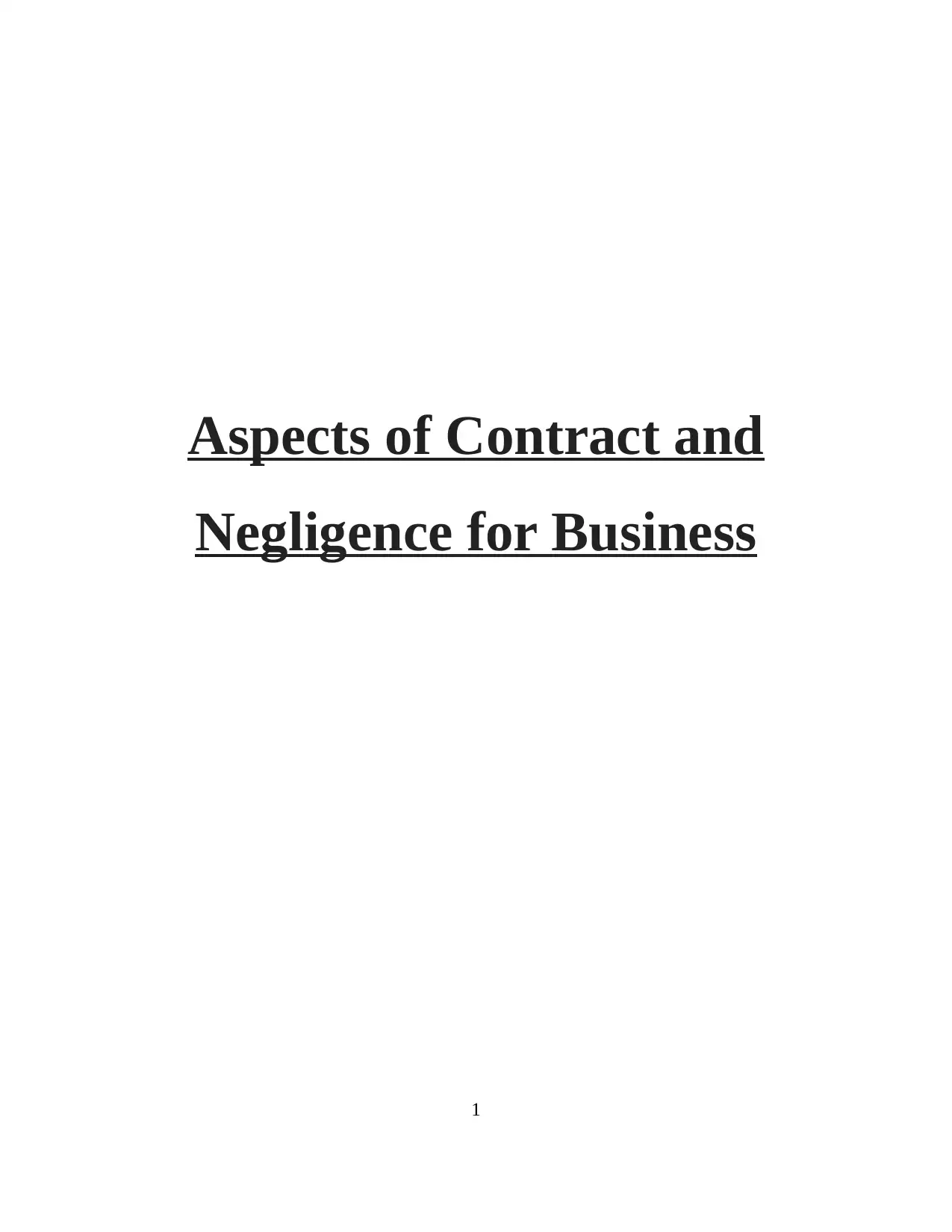
Aspects of Contract and
Negligence for Business
1
Negligence for Business
1
Secure Best Marks with AI Grader
Need help grading? Try our AI Grader for instant feedback on your assignments.
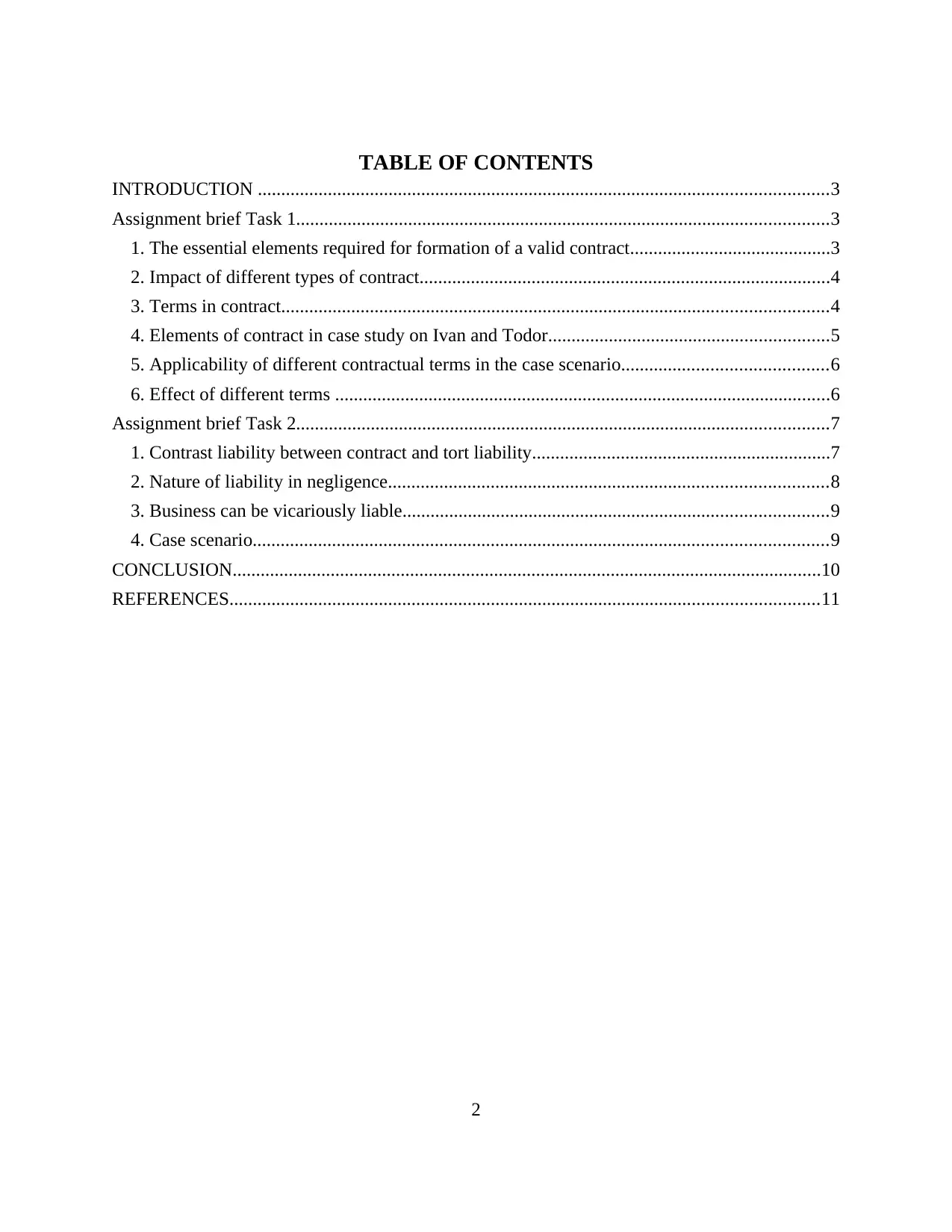
TABLE OF CONTENTS
INTRODUCTION ..........................................................................................................................3
Assignment brief Task 1..................................................................................................................3
1. The essential elements required for formation of a valid contract...........................................3
2. Impact of different types of contract........................................................................................4
3. Terms in contract.....................................................................................................................4
4. Elements of contract in case study on Ivan and Todor............................................................5
5. Applicability of different contractual terms in the case scenario............................................6
6. Effect of different terms ..........................................................................................................6
Assignment brief Task 2..................................................................................................................7
1. Contrast liability between contract and tort liability................................................................7
2. Nature of liability in negligence..............................................................................................8
3. Business can be vicariously liable...........................................................................................9
4. Case scenario...........................................................................................................................9
CONCLUSION..............................................................................................................................10
REFERENCES..............................................................................................................................11
2
INTRODUCTION ..........................................................................................................................3
Assignment brief Task 1..................................................................................................................3
1. The essential elements required for formation of a valid contract...........................................3
2. Impact of different types of contract........................................................................................4
3. Terms in contract.....................................................................................................................4
4. Elements of contract in case study on Ivan and Todor............................................................5
5. Applicability of different contractual terms in the case scenario............................................6
6. Effect of different terms ..........................................................................................................6
Assignment brief Task 2..................................................................................................................7
1. Contrast liability between contract and tort liability................................................................7
2. Nature of liability in negligence..............................................................................................8
3. Business can be vicariously liable...........................................................................................9
4. Case scenario...........................................................................................................................9
CONCLUSION..............................................................................................................................10
REFERENCES..............................................................................................................................11
2
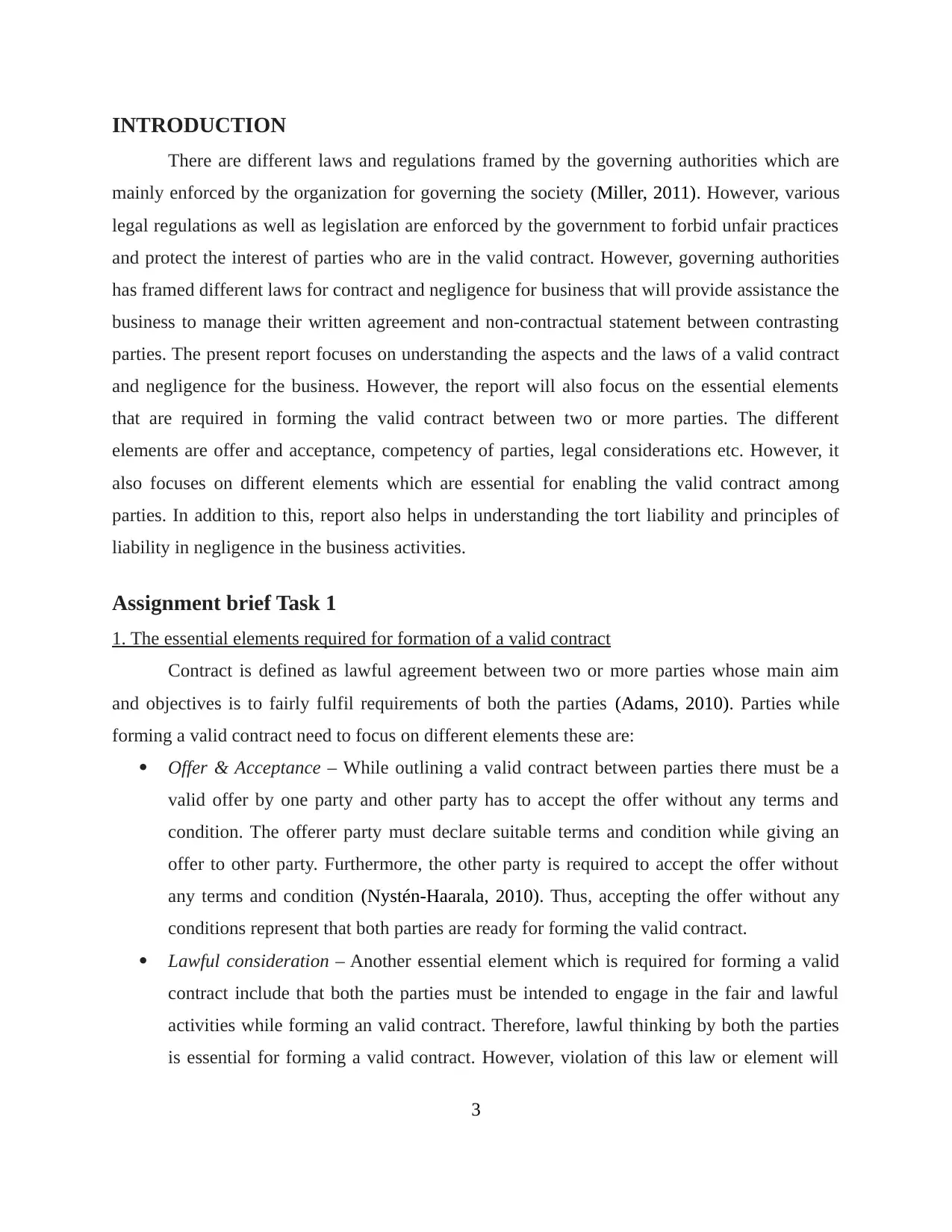
INTRODUCTION
There are different laws and regulations framed by the governing authorities which are
mainly enforced by the organization for governing the society (Miller, 2011). However, various
legal regulations as well as legislation are enforced by the government to forbid unfair practices
and protect the interest of parties who are in the valid contract. However, governing authorities
has framed different laws for contract and negligence for business that will provide assistance the
business to manage their written agreement and non-contractual statement between contrasting
parties. The present report focuses on understanding the aspects and the laws of a valid contract
and negligence for the business. However, the report will also focus on the essential elements
that are required in forming the valid contract between two or more parties. The different
elements are offer and acceptance, competency of parties, legal considerations etc. However, it
also focuses on different elements which are essential for enabling the valid contract among
parties. In addition to this, report also helps in understanding the tort liability and principles of
liability in negligence in the business activities.
Assignment brief Task 1
1. The essential elements required for formation of a valid contract
Contract is defined as lawful agreement between two or more parties whose main aim
and objectives is to fairly fulfil requirements of both the parties (Adams, 2010). Parties while
forming a valid contract need to focus on different elements these are:
Offer & Acceptance – While outlining a valid contract between parties there must be a
valid offer by one party and other party has to accept the offer without any terms and
condition. The offerer party must declare suitable terms and condition while giving an
offer to other party. Furthermore, the other party is required to accept the offer without
any terms and condition (Nystén-Haarala, 2010). Thus, accepting the offer without any
conditions represent that both parties are ready for forming the valid contract.
Lawful consideration – Another essential element which is required for forming a valid
contract include that both the parties must be intended to engage in the fair and lawful
activities while forming an valid contract. Therefore, lawful thinking by both the parties
is essential for forming a valid contract. However, violation of this law or element will
3
There are different laws and regulations framed by the governing authorities which are
mainly enforced by the organization for governing the society (Miller, 2011). However, various
legal regulations as well as legislation are enforced by the government to forbid unfair practices
and protect the interest of parties who are in the valid contract. However, governing authorities
has framed different laws for contract and negligence for business that will provide assistance the
business to manage their written agreement and non-contractual statement between contrasting
parties. The present report focuses on understanding the aspects and the laws of a valid contract
and negligence for the business. However, the report will also focus on the essential elements
that are required in forming the valid contract between two or more parties. The different
elements are offer and acceptance, competency of parties, legal considerations etc. However, it
also focuses on different elements which are essential for enabling the valid contract among
parties. In addition to this, report also helps in understanding the tort liability and principles of
liability in negligence in the business activities.
Assignment brief Task 1
1. The essential elements required for formation of a valid contract
Contract is defined as lawful agreement between two or more parties whose main aim
and objectives is to fairly fulfil requirements of both the parties (Adams, 2010). Parties while
forming a valid contract need to focus on different elements these are:
Offer & Acceptance – While outlining a valid contract between parties there must be a
valid offer by one party and other party has to accept the offer without any terms and
condition. The offerer party must declare suitable terms and condition while giving an
offer to other party. Furthermore, the other party is required to accept the offer without
any terms and condition (Nystén-Haarala, 2010). Thus, accepting the offer without any
conditions represent that both parties are ready for forming the valid contract.
Lawful consideration – Another essential element which is required for forming a valid
contract include that both the parties must be intended to engage in the fair and lawful
activities while forming an valid contract. Therefore, lawful thinking by both the parties
is essential for forming a valid contract. However, violation of this law or element will
3
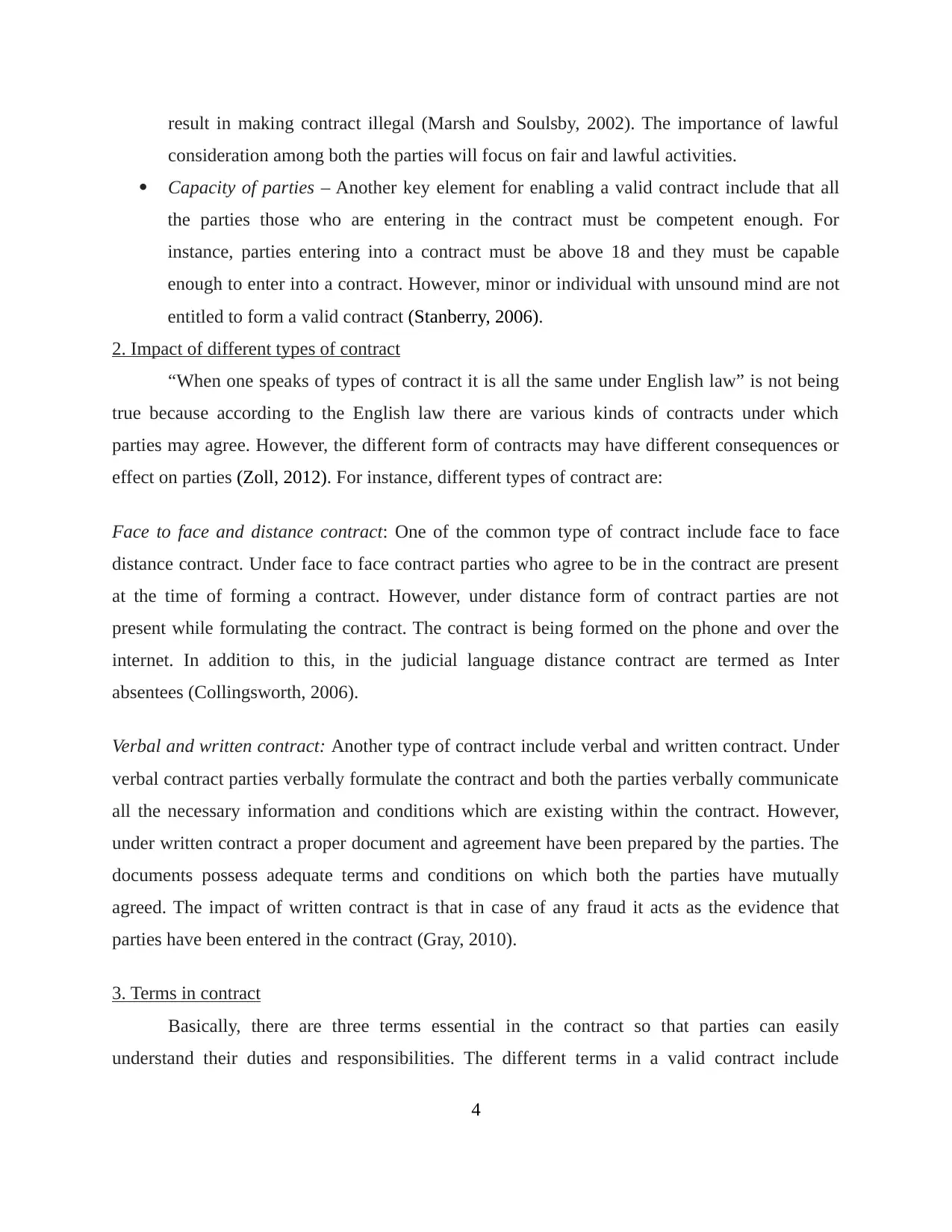
result in making contract illegal (Marsh and Soulsby, 2002). The importance of lawful
consideration among both the parties will focus on fair and lawful activities.
Capacity of parties – Another key element for enabling a valid contract include that all
the parties those who are entering in the contract must be competent enough. For
instance, parties entering into a contract must be above 18 and they must be capable
enough to enter into a contract. However, minor or individual with unsound mind are not
entitled to form a valid contract (Stanberry, 2006).
2. Impact of different types of contract
“When one speaks of types of contract it is all the same under English law” is not being
true because according to the English law there are various kinds of contracts under which
parties may agree. However, the different form of contracts may have different consequences or
effect on parties (Zoll, 2012). For instance, different types of contract are:
Face to face and distance contract: One of the common type of contract include face to face
distance contract. Under face to face contract parties who agree to be in the contract are present
at the time of forming a contract. However, under distance form of contract parties are not
present while formulating the contract. The contract is being formed on the phone and over the
internet. In addition to this, in the judicial language distance contract are termed as Inter
absentees (Collingsworth, 2006).
Verbal and written contract: Another type of contract include verbal and written contract. Under
verbal contract parties verbally formulate the contract and both the parties verbally communicate
all the necessary information and conditions which are existing within the contract. However,
under written contract a proper document and agreement have been prepared by the parties. The
documents possess adequate terms and conditions on which both the parties have mutually
agreed. The impact of written contract is that in case of any fraud it acts as the evidence that
parties have been entered in the contract (Gray, 2010).
3. Terms in contract
Basically, there are three terms essential in the contract so that parties can easily
understand their duties and responsibilities. The different terms in a valid contract include
4
consideration among both the parties will focus on fair and lawful activities.
Capacity of parties – Another key element for enabling a valid contract include that all
the parties those who are entering in the contract must be competent enough. For
instance, parties entering into a contract must be above 18 and they must be capable
enough to enter into a contract. However, minor or individual with unsound mind are not
entitled to form a valid contract (Stanberry, 2006).
2. Impact of different types of contract
“When one speaks of types of contract it is all the same under English law” is not being
true because according to the English law there are various kinds of contracts under which
parties may agree. However, the different form of contracts may have different consequences or
effect on parties (Zoll, 2012). For instance, different types of contract are:
Face to face and distance contract: One of the common type of contract include face to face
distance contract. Under face to face contract parties who agree to be in the contract are present
at the time of forming a contract. However, under distance form of contract parties are not
present while formulating the contract. The contract is being formed on the phone and over the
internet. In addition to this, in the judicial language distance contract are termed as Inter
absentees (Collingsworth, 2006).
Verbal and written contract: Another type of contract include verbal and written contract. Under
verbal contract parties verbally formulate the contract and both the parties verbally communicate
all the necessary information and conditions which are existing within the contract. However,
under written contract a proper document and agreement have been prepared by the parties. The
documents possess adequate terms and conditions on which both the parties have mutually
agreed. The impact of written contract is that in case of any fraud it acts as the evidence that
parties have been entered in the contract (Gray, 2010).
3. Terms in contract
Basically, there are three terms essential in the contract so that parties can easily
understand their duties and responsibilities. The different terms in a valid contract include
4
Secure Best Marks with AI Grader
Need help grading? Try our AI Grader for instant feedback on your assignments.
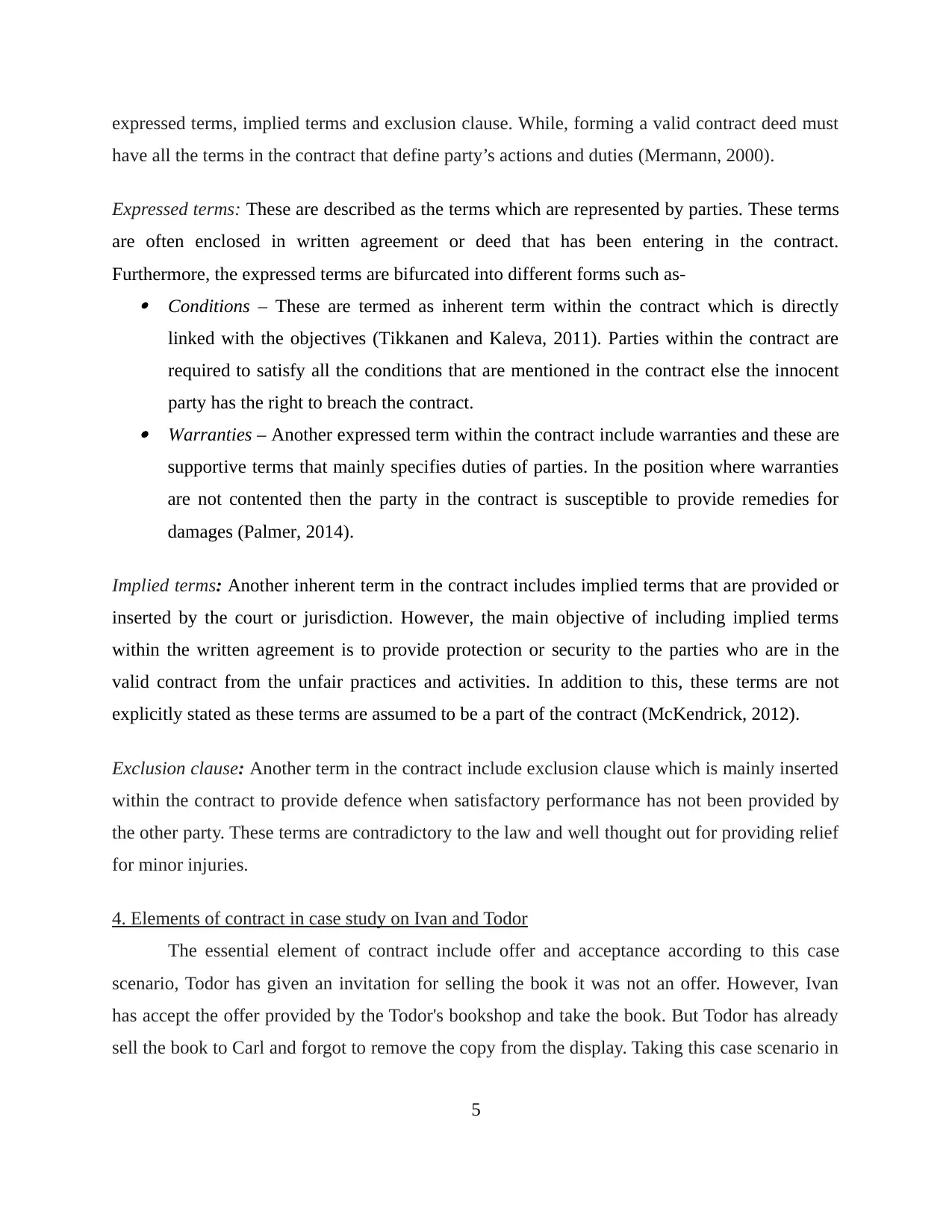
expressed terms, implied terms and exclusion clause. While, forming a valid contract deed must
have all the terms in the contract that define party’s actions and duties (Mermann, 2000).
Expressed terms: These are described as the terms which are represented by parties. These terms
are often enclosed in written agreement or deed that has been entering in the contract.
Furthermore, the expressed terms are bifurcated into different forms such as- Conditions – These are termed as inherent term within the contract which is directly
linked with the objectives (Tikkanen and Kaleva, 2011). Parties within the contract are
required to satisfy all the conditions that are mentioned in the contract else the innocent
party has the right to breach the contract. Warranties – Another expressed term within the contract include warranties and these are
supportive terms that mainly specifies duties of parties. In the position where warranties
are not contented then the party in the contract is susceptible to provide remedies for
damages (Palmer, 2014).
Implied terms: Another inherent term in the contract includes implied terms that are provided or
inserted by the court or jurisdiction. However, the main objective of including implied terms
within the written agreement is to provide protection or security to the parties who are in the
valid contract from the unfair practices and activities. In addition to this, these terms are not
explicitly stated as these terms are assumed to be a part of the contract (McKendrick, 2012).
Exclusion clause: Another term in the contract include exclusion clause which is mainly inserted
within the contract to provide defence when satisfactory performance has not been provided by
the other party. These terms are contradictory to the law and well thought out for providing relief
for minor injuries.
4. Elements of contract in case study on Ivan and Todor
The essential element of contract include offer and acceptance according to this case
scenario, Todor has given an invitation for selling the book it was not an offer. However, Ivan
has accept the offer provided by the Todor's bookshop and take the book. But Todor has already
sell the book to Carl and forgot to remove the copy from the display. Taking this case scenario in
5
have all the terms in the contract that define party’s actions and duties (Mermann, 2000).
Expressed terms: These are described as the terms which are represented by parties. These terms
are often enclosed in written agreement or deed that has been entering in the contract.
Furthermore, the expressed terms are bifurcated into different forms such as- Conditions – These are termed as inherent term within the contract which is directly
linked with the objectives (Tikkanen and Kaleva, 2011). Parties within the contract are
required to satisfy all the conditions that are mentioned in the contract else the innocent
party has the right to breach the contract. Warranties – Another expressed term within the contract include warranties and these are
supportive terms that mainly specifies duties of parties. In the position where warranties
are not contented then the party in the contract is susceptible to provide remedies for
damages (Palmer, 2014).
Implied terms: Another inherent term in the contract includes implied terms that are provided or
inserted by the court or jurisdiction. However, the main objective of including implied terms
within the written agreement is to provide protection or security to the parties who are in the
valid contract from the unfair practices and activities. In addition to this, these terms are not
explicitly stated as these terms are assumed to be a part of the contract (McKendrick, 2012).
Exclusion clause: Another term in the contract include exclusion clause which is mainly inserted
within the contract to provide defence when satisfactory performance has not been provided by
the other party. These terms are contradictory to the law and well thought out for providing relief
for minor injuries.
4. Elements of contract in case study on Ivan and Todor
The essential element of contract include offer and acceptance according to this case
scenario, Todor has given an invitation for selling the book it was not an offer. However, Ivan
has accept the offer provided by the Todor's bookshop and take the book. But Todor has already
sell the book to Carl and forgot to remove the copy from the display. Taking this case scenario in
5
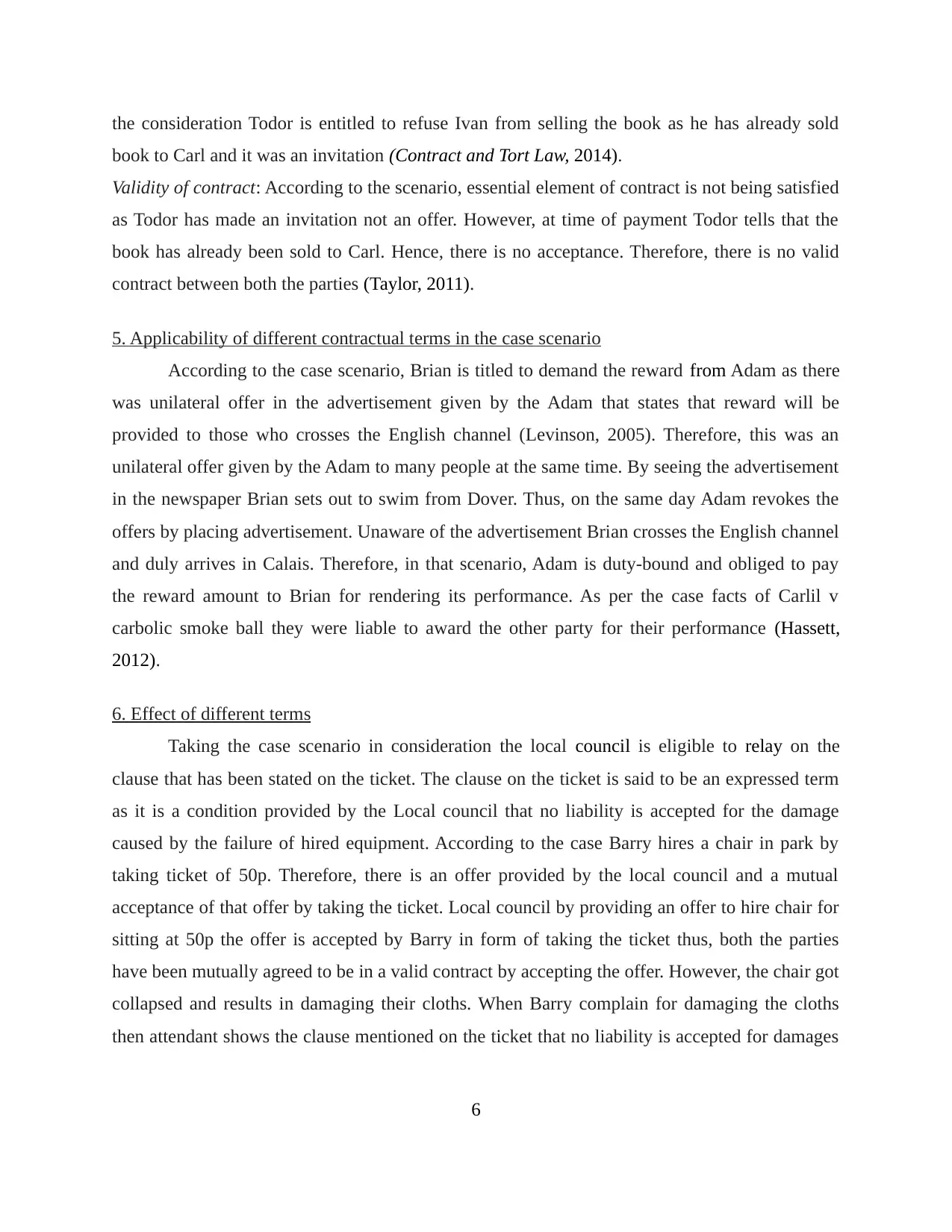
the consideration Todor is entitled to refuse Ivan from selling the book as he has already sold
book to Carl and it was an invitation (Contract and Tort Law, 2014).
Validity of contract: According to the scenario, essential element of contract is not being satisfied
as Todor has made an invitation not an offer. However, at time of payment Todor tells that the
book has already been sold to Carl. Hence, there is no acceptance. Therefore, there is no valid
contract between both the parties (Taylor, 2011).
5. Applicability of different contractual terms in the case scenario
According to the case scenario, Brian is titled to demand the reward from Adam as there
was unilateral offer in the advertisement given by the Adam that states that reward will be
provided to those who crosses the English channel (Levinson, 2005). Therefore, this was an
unilateral offer given by the Adam to many people at the same time. By seeing the advertisement
in the newspaper Brian sets out to swim from Dover. Thus, on the same day Adam revokes the
offers by placing advertisement. Unaware of the advertisement Brian crosses the English channel
and duly arrives in Calais. Therefore, in that scenario, Adam is duty-bound and obliged to pay
the reward amount to Brian for rendering its performance. As per the case facts of Carlil v
carbolic smoke ball they were liable to award the other party for their performance (Hassett,
2012).
6. Effect of different terms
Taking the case scenario in consideration the local council is eligible to relay on the
clause that has been stated on the ticket. The clause on the ticket is said to be an expressed term
as it is a condition provided by the Local council that no liability is accepted for the damage
caused by the failure of hired equipment. According to the case Barry hires a chair in park by
taking ticket of 50p. Therefore, there is an offer provided by the local council and a mutual
acceptance of that offer by taking the ticket. Local council by providing an offer to hire chair for
sitting at 50p the offer is accepted by Barry in form of taking the ticket thus, both the parties
have been mutually agreed to be in a valid contract by accepting the offer. However, the chair got
collapsed and results in damaging their cloths. When Barry complain for damaging the cloths
then attendant shows the clause mentioned on the ticket that no liability is accepted for damages
6
book to Carl and it was an invitation (Contract and Tort Law, 2014).
Validity of contract: According to the scenario, essential element of contract is not being satisfied
as Todor has made an invitation not an offer. However, at time of payment Todor tells that the
book has already been sold to Carl. Hence, there is no acceptance. Therefore, there is no valid
contract between both the parties (Taylor, 2011).
5. Applicability of different contractual terms in the case scenario
According to the case scenario, Brian is titled to demand the reward from Adam as there
was unilateral offer in the advertisement given by the Adam that states that reward will be
provided to those who crosses the English channel (Levinson, 2005). Therefore, this was an
unilateral offer given by the Adam to many people at the same time. By seeing the advertisement
in the newspaper Brian sets out to swim from Dover. Thus, on the same day Adam revokes the
offers by placing advertisement. Unaware of the advertisement Brian crosses the English channel
and duly arrives in Calais. Therefore, in that scenario, Adam is duty-bound and obliged to pay
the reward amount to Brian for rendering its performance. As per the case facts of Carlil v
carbolic smoke ball they were liable to award the other party for their performance (Hassett,
2012).
6. Effect of different terms
Taking the case scenario in consideration the local council is eligible to relay on the
clause that has been stated on the ticket. The clause on the ticket is said to be an expressed term
as it is a condition provided by the Local council that no liability is accepted for the damage
caused by the failure of hired equipment. According to the case Barry hires a chair in park by
taking ticket of 50p. Therefore, there is an offer provided by the local council and a mutual
acceptance of that offer by taking the ticket. Local council by providing an offer to hire chair for
sitting at 50p the offer is accepted by Barry in form of taking the ticket thus, both the parties
have been mutually agreed to be in a valid contract by accepting the offer. However, the chair got
collapsed and results in damaging their cloths. When Barry complain for damaging the cloths
then attendant shows the clause mentioned on the ticket that no liability is accepted for damages
6
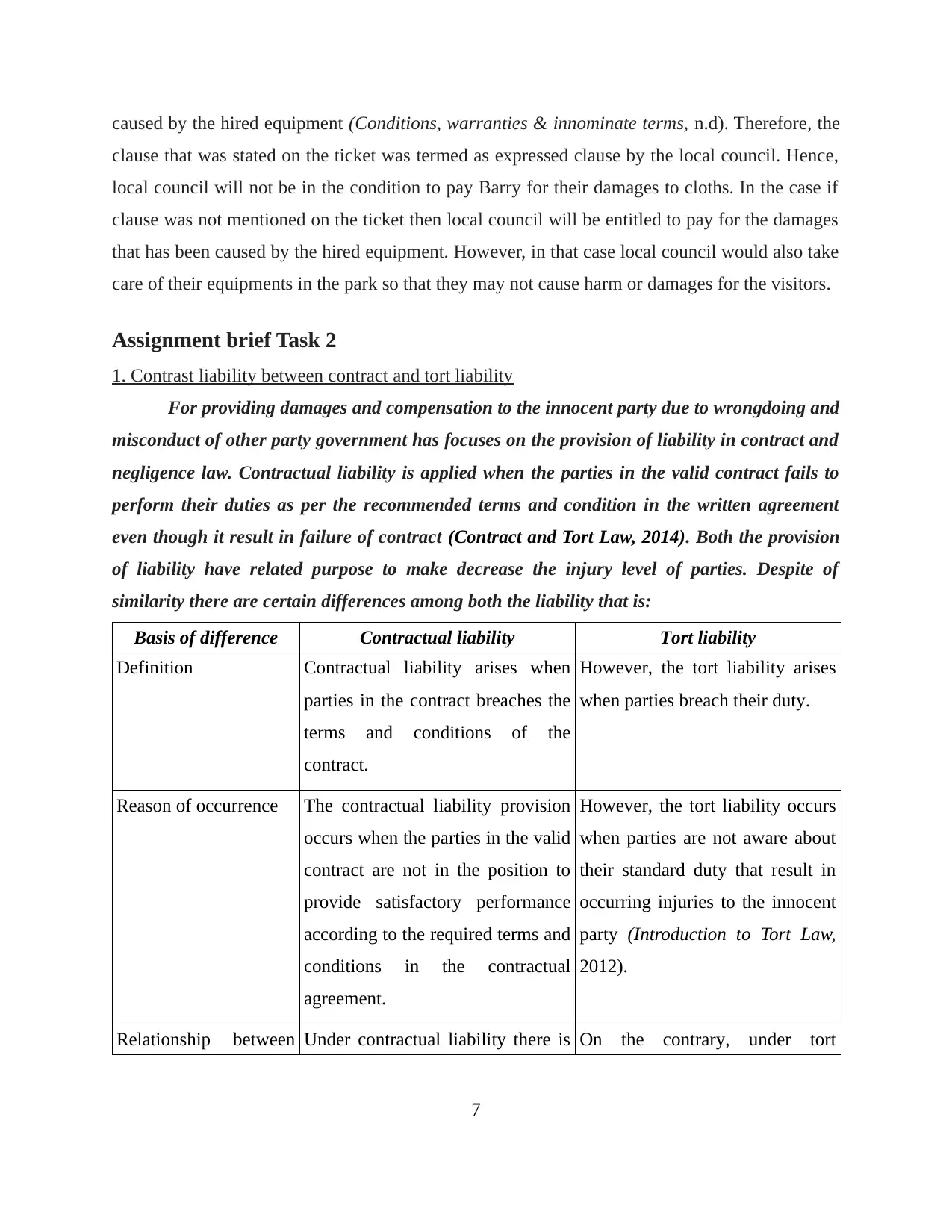
caused by the hired equipment (Conditions, warranties & innominate terms, n.d). Therefore, the
clause that was stated on the ticket was termed as expressed clause by the local council. Hence,
local council will not be in the condition to pay Barry for their damages to cloths. In the case if
clause was not mentioned on the ticket then local council will be entitled to pay for the damages
that has been caused by the hired equipment. However, in that case local council would also take
care of their equipments in the park so that they may not cause harm or damages for the visitors.
Assignment brief Task 2
1. Contrast liability between contract and tort liability
For providing damages and compensation to the innocent party due to wrongdoing and
misconduct of other party government has focuses on the provision of liability in contract and
negligence law. Contractual liability is applied when the parties in the valid contract fails to
perform their duties as per the recommended terms and condition in the written agreement
even though it result in failure of contract (Contract and Tort Law, 2014). Both the provision
of liability have related purpose to make decrease the injury level of parties. Despite of
similarity there are certain differences among both the liability that is:
Basis of difference Contractual liability Tort liability
Definition Contractual liability arises when
parties in the contract breaches the
terms and conditions of the
contract.
However, the tort liability arises
when parties breach their duty.
Reason of occurrence The contractual liability provision
occurs when the parties in the valid
contract are not in the position to
provide satisfactory performance
according to the required terms and
conditions in the contractual
agreement.
However, the tort liability occurs
when parties are not aware about
their standard duty that result in
occurring injuries to the innocent
party (Introduction to Tort Law,
2012).
Relationship between Under contractual liability there is On the contrary, under tort
7
clause that was stated on the ticket was termed as expressed clause by the local council. Hence,
local council will not be in the condition to pay Barry for their damages to cloths. In the case if
clause was not mentioned on the ticket then local council will be entitled to pay for the damages
that has been caused by the hired equipment. However, in that case local council would also take
care of their equipments in the park so that they may not cause harm or damages for the visitors.
Assignment brief Task 2
1. Contrast liability between contract and tort liability
For providing damages and compensation to the innocent party due to wrongdoing and
misconduct of other party government has focuses on the provision of liability in contract and
negligence law. Contractual liability is applied when the parties in the valid contract fails to
perform their duties as per the recommended terms and condition in the written agreement
even though it result in failure of contract (Contract and Tort Law, 2014). Both the provision
of liability have related purpose to make decrease the injury level of parties. Despite of
similarity there are certain differences among both the liability that is:
Basis of difference Contractual liability Tort liability
Definition Contractual liability arises when
parties in the contract breaches the
terms and conditions of the
contract.
However, the tort liability arises
when parties breach their duty.
Reason of occurrence The contractual liability provision
occurs when the parties in the valid
contract are not in the position to
provide satisfactory performance
according to the required terms and
conditions in the contractual
agreement.
However, the tort liability occurs
when parties are not aware about
their standard duty that result in
occurring injuries to the innocent
party (Introduction to Tort Law,
2012).
Relationship between Under contractual liability there is On the contrary, under tort
7
Paraphrase This Document
Need a fresh take? Get an instant paraphrase of this document with our AI Paraphraser
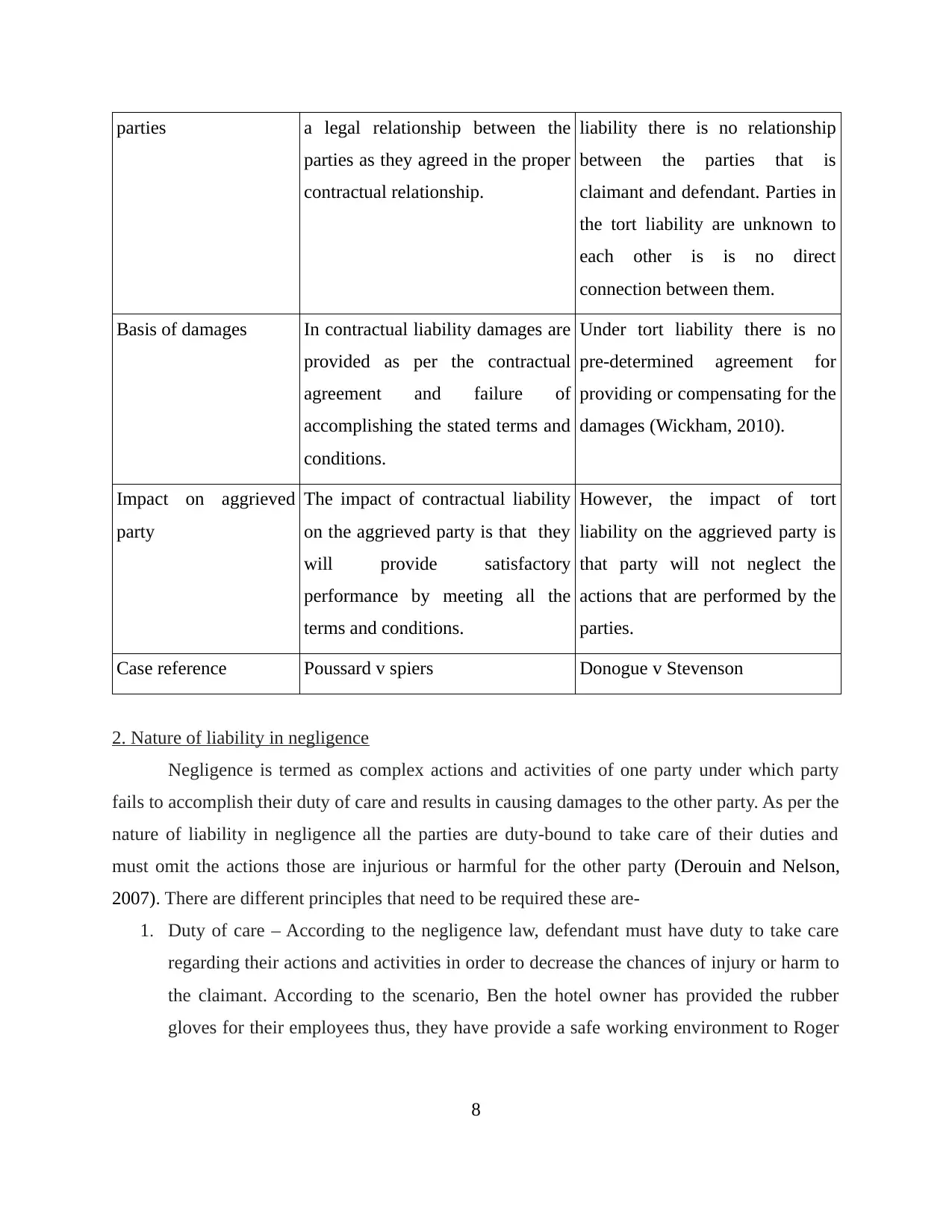
parties a legal relationship between the
parties as they agreed in the proper
contractual relationship.
liability there is no relationship
between the parties that is
claimant and defendant. Parties in
the tort liability are unknown to
each other is is no direct
connection between them.
Basis of damages In contractual liability damages are
provided as per the contractual
agreement and failure of
accomplishing the stated terms and
conditions.
Under tort liability there is no
pre-determined agreement for
providing or compensating for the
damages (Wickham, 2010).
Impact on aggrieved
party
The impact of contractual liability
on the aggrieved party is that they
will provide satisfactory
performance by meeting all the
terms and conditions.
However, the impact of tort
liability on the aggrieved party is
that party will not neglect the
actions that are performed by the
parties.
Case reference Poussard v spiers Donogue v Stevenson
2. Nature of liability in negligence
Negligence is termed as complex actions and activities of one party under which party
fails to accomplish their duty of care and results in causing damages to the other party. As per the
nature of liability in negligence all the parties are duty-bound to take care of their duties and
must omit the actions those are injurious or harmful for the other party (Derouin and Nelson,
2007). There are different principles that need to be required these are-
1. Duty of care – According to the negligence law, defendant must have duty to take care
regarding their actions and activities in order to decrease the chances of injury or harm to
the claimant. According to the scenario, Ben the hotel owner has provided the rubber
gloves for their employees thus, they have provide a safe working environment to Roger
8
parties as they agreed in the proper
contractual relationship.
liability there is no relationship
between the parties that is
claimant and defendant. Parties in
the tort liability are unknown to
each other is is no direct
connection between them.
Basis of damages In contractual liability damages are
provided as per the contractual
agreement and failure of
accomplishing the stated terms and
conditions.
Under tort liability there is no
pre-determined agreement for
providing or compensating for the
damages (Wickham, 2010).
Impact on aggrieved
party
The impact of contractual liability
on the aggrieved party is that they
will provide satisfactory
performance by meeting all the
terms and conditions.
However, the impact of tort
liability on the aggrieved party is
that party will not neglect the
actions that are performed by the
parties.
Case reference Poussard v spiers Donogue v Stevenson
2. Nature of liability in negligence
Negligence is termed as complex actions and activities of one party under which party
fails to accomplish their duty of care and results in causing damages to the other party. As per the
nature of liability in negligence all the parties are duty-bound to take care of their duties and
must omit the actions those are injurious or harmful for the other party (Derouin and Nelson,
2007). There are different principles that need to be required these are-
1. Duty of care – According to the negligence law, defendant must have duty to take care
regarding their actions and activities in order to decrease the chances of injury or harm to
the claimant. According to the scenario, Ben the hotel owner has provided the rubber
gloves for their employees thus, they have provide a safe working environment to Roger
8
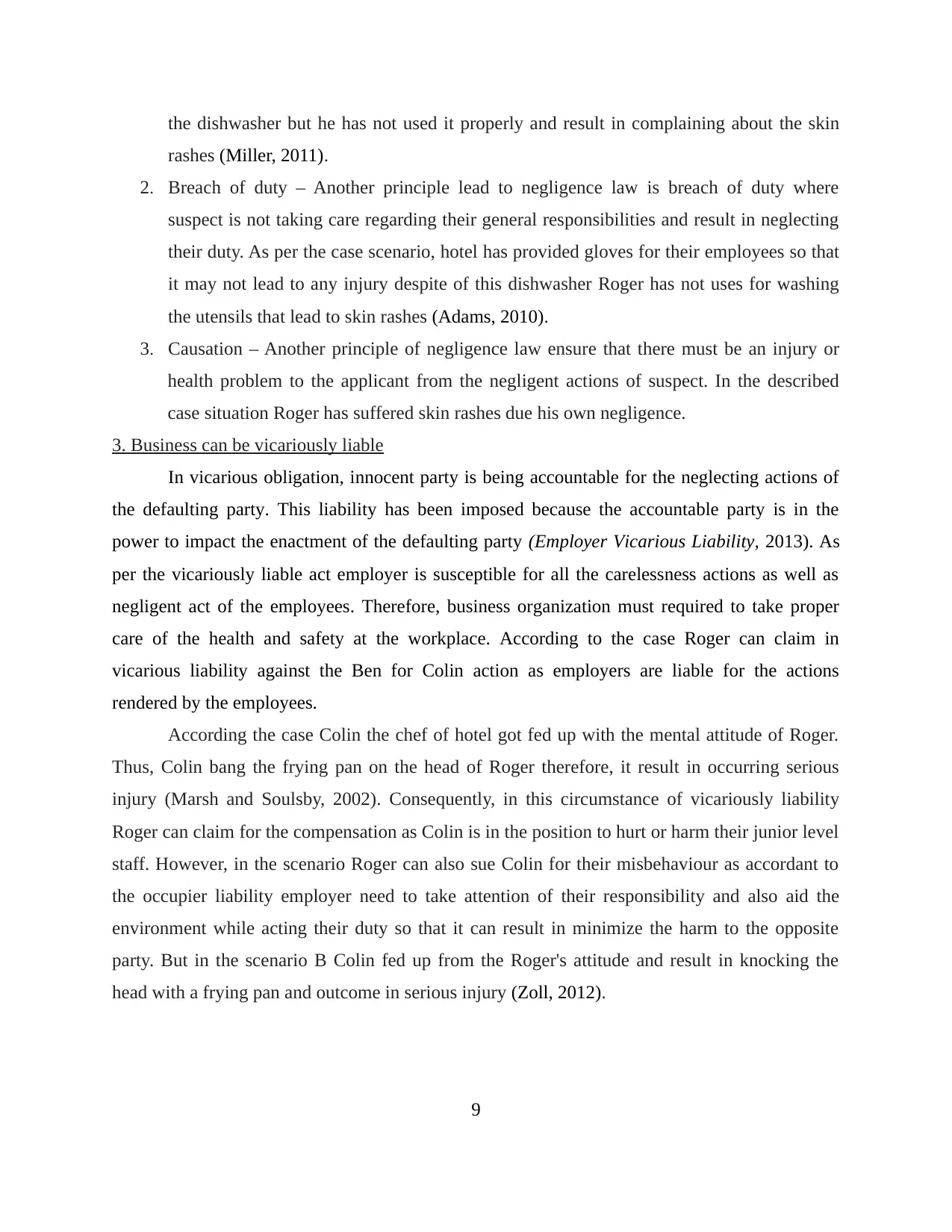
the dishwasher but he has not used it properly and result in complaining about the skin
rashes (Miller, 2011).
2. Breach of duty – Another principle lead to negligence law is breach of duty where
suspect is not taking care regarding their general responsibilities and result in neglecting
their duty. As per the case scenario, hotel has provided gloves for their employees so that
it may not lead to any injury despite of this dishwasher Roger has not uses for washing
the utensils that lead to skin rashes (Adams, 2010).
3. Causation – Another principle of negligence law ensure that there must be an injury or
health problem to the applicant from the negligent actions of suspect. In the described
case situation Roger has suffered skin rashes due his own negligence.
3. Business can be vicariously liable
In vicarious obligation, innocent party is being accountable for the neglecting actions of
the defaulting party. This liability has been imposed because the accountable party is in the
power to impact the enactment of the defaulting party (Employer Vicarious Liability, 2013). As
per the vicariously liable act employer is susceptible for all the carelessness actions as well as
negligent act of the employees. Therefore, business organization must required to take proper
care of the health and safety at the workplace. According to the case Roger can claim in
vicarious liability against the Ben for Colin action as employers are liable for the actions
rendered by the employees.
According the case Colin the chef of hotel got fed up with the mental attitude of Roger.
Thus, Colin bang the frying pan on the head of Roger therefore, it result in occurring serious
injury (Marsh and Soulsby, 2002). Consequently, in this circumstance of vicariously liability
Roger can claim for the compensation as Colin is in the position to hurt or harm their junior level
staff. However, in the scenario Roger can also sue Colin for their misbehaviour as accordant to
the occupier liability employer need to take attention of their responsibility and also aid the
environment while acting their duty so that it can result in minimize the harm to the opposite
party. But in the scenario B Colin fed up from the Roger's attitude and result in knocking the
head with a frying pan and outcome in serious injury (Zoll, 2012).
9
rashes (Miller, 2011).
2. Breach of duty – Another principle lead to negligence law is breach of duty where
suspect is not taking care regarding their general responsibilities and result in neglecting
their duty. As per the case scenario, hotel has provided gloves for their employees so that
it may not lead to any injury despite of this dishwasher Roger has not uses for washing
the utensils that lead to skin rashes (Adams, 2010).
3. Causation – Another principle of negligence law ensure that there must be an injury or
health problem to the applicant from the negligent actions of suspect. In the described
case situation Roger has suffered skin rashes due his own negligence.
3. Business can be vicariously liable
In vicarious obligation, innocent party is being accountable for the neglecting actions of
the defaulting party. This liability has been imposed because the accountable party is in the
power to impact the enactment of the defaulting party (Employer Vicarious Liability, 2013). As
per the vicariously liable act employer is susceptible for all the carelessness actions as well as
negligent act of the employees. Therefore, business organization must required to take proper
care of the health and safety at the workplace. According to the case Roger can claim in
vicarious liability against the Ben for Colin action as employers are liable for the actions
rendered by the employees.
According the case Colin the chef of hotel got fed up with the mental attitude of Roger.
Thus, Colin bang the frying pan on the head of Roger therefore, it result in occurring serious
injury (Marsh and Soulsby, 2002). Consequently, in this circumstance of vicariously liability
Roger can claim for the compensation as Colin is in the position to hurt or harm their junior level
staff. However, in the scenario Roger can also sue Colin for their misbehaviour as accordant to
the occupier liability employer need to take attention of their responsibility and also aid the
environment while acting their duty so that it can result in minimize the harm to the opposite
party. But in the scenario B Colin fed up from the Roger's attitude and result in knocking the
head with a frying pan and outcome in serious injury (Zoll, 2012).
9
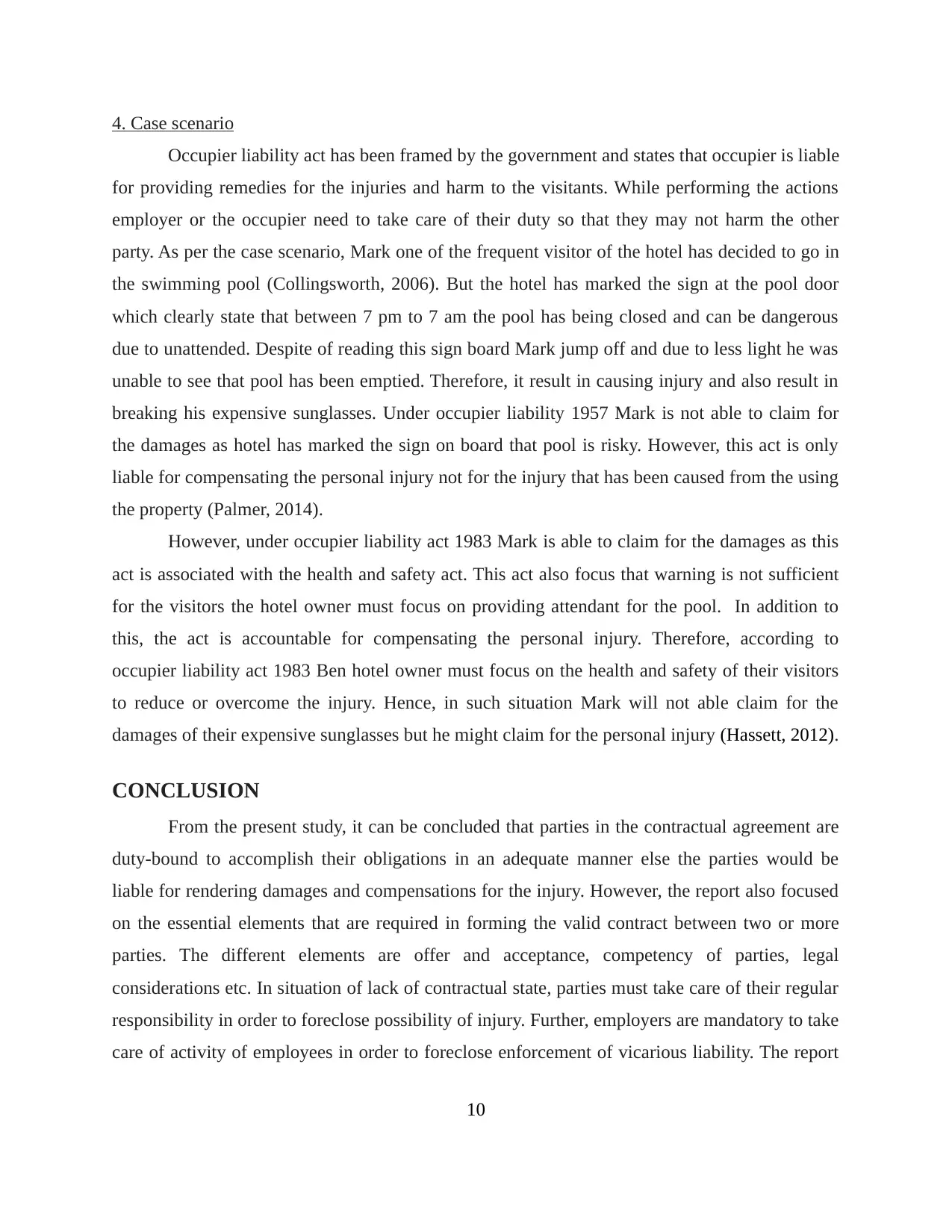
4. Case scenario
Occupier liability act has been framed by the government and states that occupier is liable
for providing remedies for the injuries and harm to the visitants. While performing the actions
employer or the occupier need to take care of their duty so that they may not harm the other
party. As per the case scenario, Mark one of the frequent visitor of the hotel has decided to go in
the swimming pool (Collingsworth, 2006). But the hotel has marked the sign at the pool door
which clearly state that between 7 pm to 7 am the pool has being closed and can be dangerous
due to unattended. Despite of reading this sign board Mark jump off and due to less light he was
unable to see that pool has been emptied. Therefore, it result in causing injury and also result in
breaking his expensive sunglasses. Under occupier liability 1957 Mark is not able to claim for
the damages as hotel has marked the sign on board that pool is risky. However, this act is only
liable for compensating the personal injury not for the injury that has been caused from the using
the property (Palmer, 2014).
However, under occupier liability act 1983 Mark is able to claim for the damages as this
act is associated with the health and safety act. This act also focus that warning is not sufficient
for the visitors the hotel owner must focus on providing attendant for the pool. In addition to
this, the act is accountable for compensating the personal injury. Therefore, according to
occupier liability act 1983 Ben hotel owner must focus on the health and safety of their visitors
to reduce or overcome the injury. Hence, in such situation Mark will not able claim for the
damages of their expensive sunglasses but he might claim for the personal injury (Hassett, 2012).
CONCLUSION
From the present study, it can be concluded that parties in the contractual agreement are
duty-bound to accomplish their obligations in an adequate manner else the parties would be
liable for rendering damages and compensations for the injury. However, the report also focused
on the essential elements that are required in forming the valid contract between two or more
parties. The different elements are offer and acceptance, competency of parties, legal
considerations etc. In situation of lack of contractual state, parties must take care of their regular
responsibility in order to foreclose possibility of injury. Further, employers are mandatory to take
care of activity of employees in order to foreclose enforcement of vicarious liability. The report
10
Occupier liability act has been framed by the government and states that occupier is liable
for providing remedies for the injuries and harm to the visitants. While performing the actions
employer or the occupier need to take care of their duty so that they may not harm the other
party. As per the case scenario, Mark one of the frequent visitor of the hotel has decided to go in
the swimming pool (Collingsworth, 2006). But the hotel has marked the sign at the pool door
which clearly state that between 7 pm to 7 am the pool has being closed and can be dangerous
due to unattended. Despite of reading this sign board Mark jump off and due to less light he was
unable to see that pool has been emptied. Therefore, it result in causing injury and also result in
breaking his expensive sunglasses. Under occupier liability 1957 Mark is not able to claim for
the damages as hotel has marked the sign on board that pool is risky. However, this act is only
liable for compensating the personal injury not for the injury that has been caused from the using
the property (Palmer, 2014).
However, under occupier liability act 1983 Mark is able to claim for the damages as this
act is associated with the health and safety act. This act also focus that warning is not sufficient
for the visitors the hotel owner must focus on providing attendant for the pool. In addition to
this, the act is accountable for compensating the personal injury. Therefore, according to
occupier liability act 1983 Ben hotel owner must focus on the health and safety of their visitors
to reduce or overcome the injury. Hence, in such situation Mark will not able claim for the
damages of their expensive sunglasses but he might claim for the personal injury (Hassett, 2012).
CONCLUSION
From the present study, it can be concluded that parties in the contractual agreement are
duty-bound to accomplish their obligations in an adequate manner else the parties would be
liable for rendering damages and compensations for the injury. However, the report also focused
on the essential elements that are required in forming the valid contract between two or more
parties. The different elements are offer and acceptance, competency of parties, legal
considerations etc. In situation of lack of contractual state, parties must take care of their regular
responsibility in order to foreclose possibility of injury. Further, employers are mandatory to take
care of activity of employees in order to foreclose enforcement of vicarious liability. The report
10
Secure Best Marks with AI Grader
Need help grading? Try our AI Grader for instant feedback on your assignments.
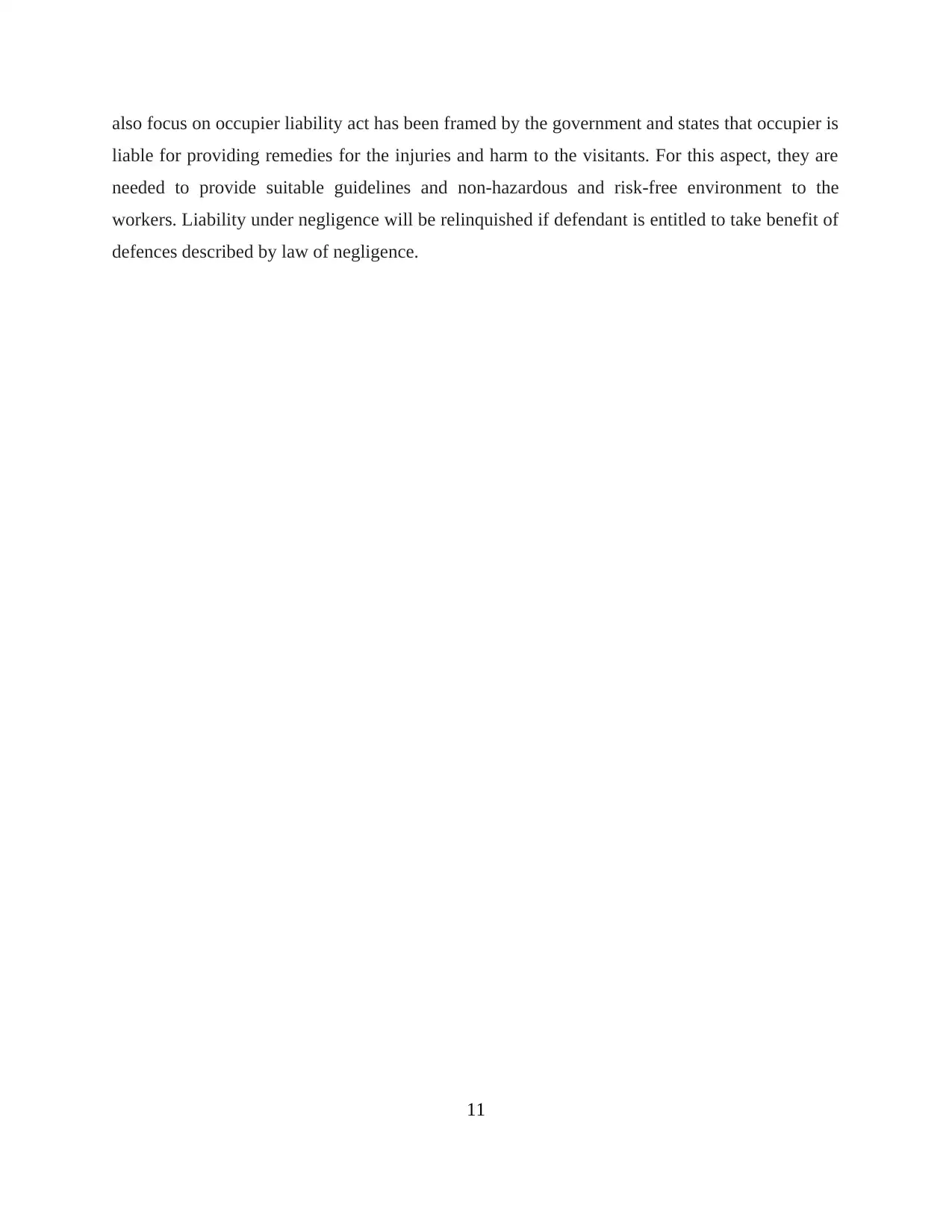
also focus on occupier liability act has been framed by the government and states that occupier is
liable for providing remedies for the injuries and harm to the visitants. For this aspect, they are
needed to provide suitable guidelines and non-hazardous and risk-free environment to the
workers. Liability under negligence will be relinquished if defendant is entitled to take benefit of
defences described by law of negligence.
11
liable for providing remedies for the injuries and harm to the visitants. For this aspect, they are
needed to provide suitable guidelines and non-hazardous and risk-free environment to the
workers. Liability under negligence will be relinquished if defendant is entitled to take benefit of
defences described by law of negligence.
11
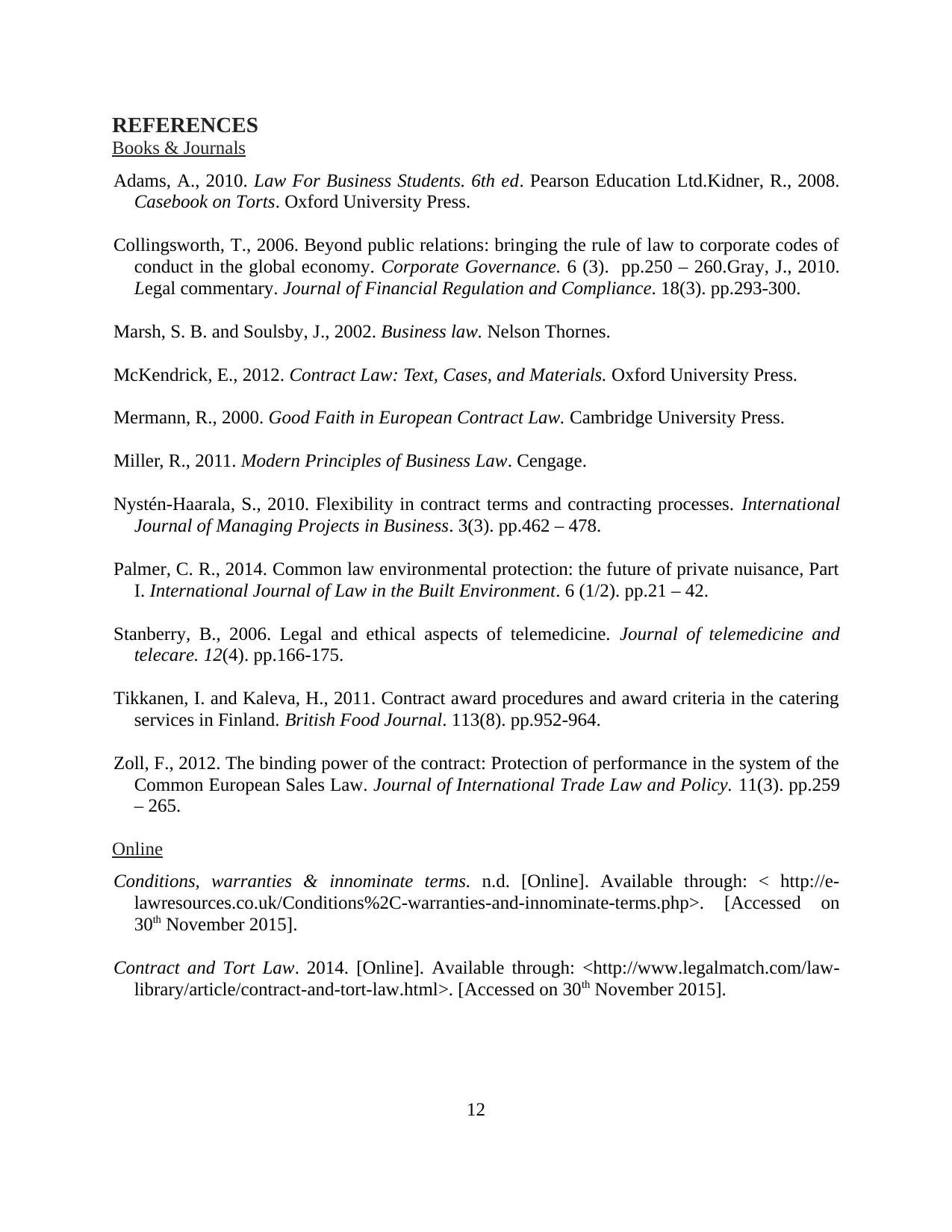
REFERENCES
Books & Journals
Adams, A., 2010. Law For Business Students. 6th ed. Pearson Education Ltd.Kidner, R., 2008.
Casebook on Torts. Oxford University Press.
Collingsworth, T., 2006. Beyond public relations: bringing the rule of law to corporate codes of
conduct in the global economy. Corporate Governance. 6 (3). pp.250 – 260.Gray, J., 2010.
Legal commentary. Journal of Financial Regulation and Compliance. 18(3). pp.293-300.
Marsh, S. B. and Soulsby, J., 2002. Business law. Nelson Thornes.
McKendrick, E., 2012. Contract Law: Text, Cases, and Materials. Oxford University Press.
Mermann, R., 2000. Good Faith in European Contract Law. Cambridge University Press.
Miller, R., 2011. Modern Principles of Business Law. Cengage.
Nystén-Haarala, S., 2010. Flexibility in contract terms and contracting processes. International
Journal of Managing Projects in Business. 3(3). pp.462 – 478.
Palmer, C. R., 2014. Common law environmental protection: the future of private nuisance, Part
I. International Journal of Law in the Built Environment. 6 (1/2). pp.21 – 42.
Stanberry, B., 2006. Legal and ethical aspects of telemedicine. Journal of telemedicine and
telecare. 12(4). pp.166-175.
Tikkanen, I. and Kaleva, H., 2011. Contract award procedures and award criteria in the catering
services in Finland. British Food Journal. 113(8). pp.952-964.
Zoll, F., 2012. The binding power of the contract: Protection of performance in the system of the
Common European Sales Law. Journal of International Trade Law and Policy. 11(3). pp.259
– 265.
Online
Conditions, warranties & innominate terms. n.d. [Online]. Available through: < http://e-
lawresources.co.uk/Conditions%2C-warranties-and-innominate-terms.php>. [Accessed on
30th November 2015].
Contract and Tort Law. 2014. [Online]. Available through: <http://www.legalmatch.com/law-
library/article/contract-and-tort-law.html>. [Accessed on 30th November 2015].
12
Books & Journals
Adams, A., 2010. Law For Business Students. 6th ed. Pearson Education Ltd.Kidner, R., 2008.
Casebook on Torts. Oxford University Press.
Collingsworth, T., 2006. Beyond public relations: bringing the rule of law to corporate codes of
conduct in the global economy. Corporate Governance. 6 (3). pp.250 – 260.Gray, J., 2010.
Legal commentary. Journal of Financial Regulation and Compliance. 18(3). pp.293-300.
Marsh, S. B. and Soulsby, J., 2002. Business law. Nelson Thornes.
McKendrick, E., 2012. Contract Law: Text, Cases, and Materials. Oxford University Press.
Mermann, R., 2000. Good Faith in European Contract Law. Cambridge University Press.
Miller, R., 2011. Modern Principles of Business Law. Cengage.
Nystén-Haarala, S., 2010. Flexibility in contract terms and contracting processes. International
Journal of Managing Projects in Business. 3(3). pp.462 – 478.
Palmer, C. R., 2014. Common law environmental protection: the future of private nuisance, Part
I. International Journal of Law in the Built Environment. 6 (1/2). pp.21 – 42.
Stanberry, B., 2006. Legal and ethical aspects of telemedicine. Journal of telemedicine and
telecare. 12(4). pp.166-175.
Tikkanen, I. and Kaleva, H., 2011. Contract award procedures and award criteria in the catering
services in Finland. British Food Journal. 113(8). pp.952-964.
Zoll, F., 2012. The binding power of the contract: Protection of performance in the system of the
Common European Sales Law. Journal of International Trade Law and Policy. 11(3). pp.259
– 265.
Online
Conditions, warranties & innominate terms. n.d. [Online]. Available through: < http://e-
lawresources.co.uk/Conditions%2C-warranties-and-innominate-terms.php>. [Accessed on
30th November 2015].
Contract and Tort Law. 2014. [Online]. Available through: <http://www.legalmatch.com/law-
library/article/contract-and-tort-law.html>. [Accessed on 30th November 2015].
12
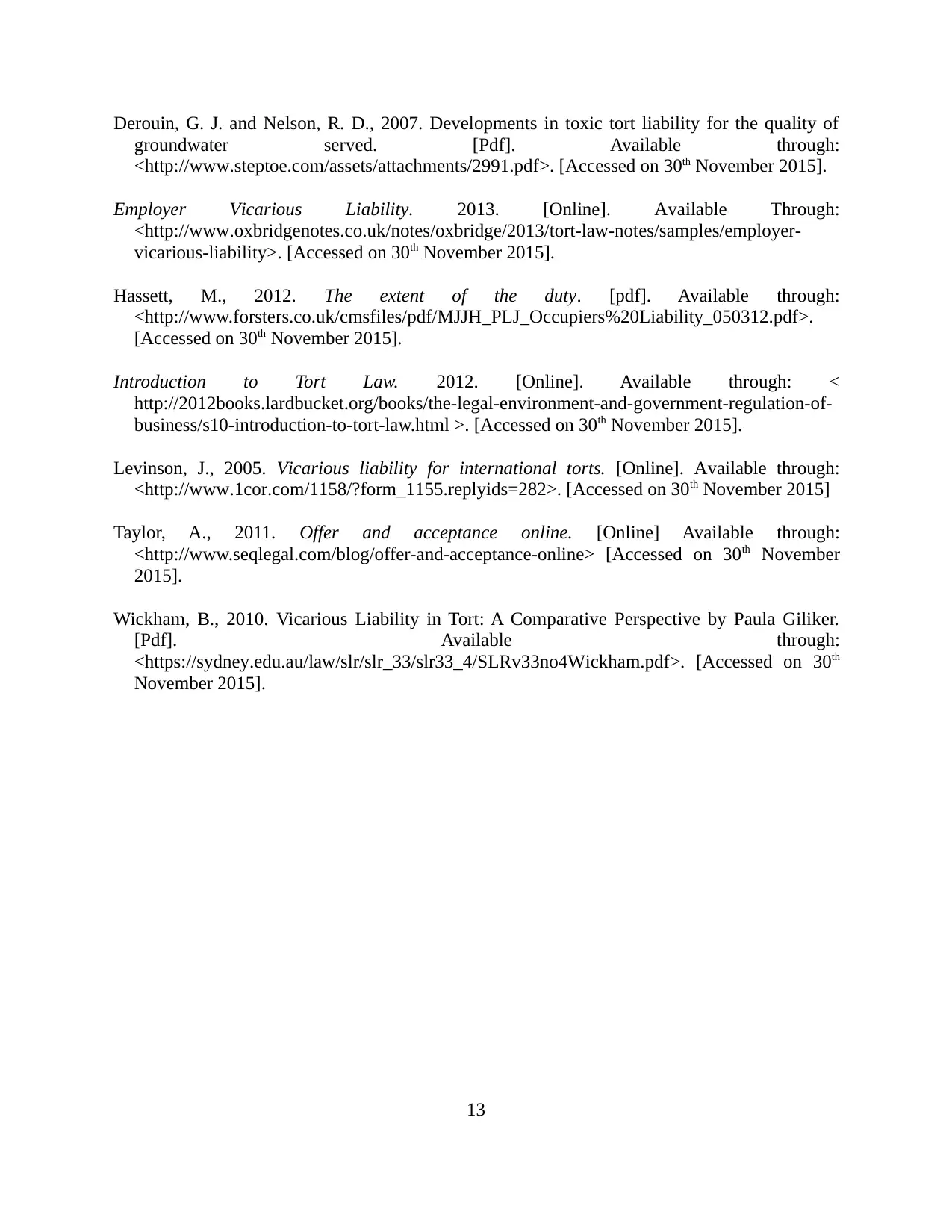
Derouin, G. J. and Nelson, R. D., 2007. Developments in toxic tort liability for the quality of
groundwater served. [Pdf]. Available through:
<http://www.steptoe.com/assets/attachments/2991.pdf>. [Accessed on 30th November 2015].
Employer Vicarious Liability. 2013. [Online]. Available Through:
<http://www.oxbridgenotes.co.uk/notes/oxbridge/2013/tort-law-notes/samples/employer-
vicarious-liability>. [Accessed on 30th November 2015].
Hassett, M., 2012. The extent of the duty. [pdf]. Available through:
<http://www.forsters.co.uk/cmsfiles/pdf/MJJH_PLJ_Occupiers%20Liability_050312.pdf>.
[Accessed on 30th November 2015].
Introduction to Tort Law. 2012. [Online]. Available through: <
http://2012books.lardbucket.org/books/the-legal-environment-and-government-regulation-of-
business/s10-introduction-to-tort-law.html >. [Accessed on 30th November 2015].
Levinson, J., 2005. Vicarious liability for international torts. [Online]. Available through:
<http://www.1cor.com/1158/?form_1155.replyids=282>. [Accessed on 30th November 2015]
Taylor, A., 2011. Offer and acceptance online. [Online] Available through:
<http://www.seqlegal.com/blog/offer-and-acceptance-online> [Accessed on 30th November
2015].
Wickham, B., 2010. Vicarious Liability in Tort: A Comparative Perspective by Paula Giliker.
[Pdf]. Available through:
<https://sydney.edu.au/law/slr/slr_33/slr33_4/SLRv33no4Wickham.pdf>. [Accessed on 30th
November 2015].
13
groundwater served. [Pdf]. Available through:
<http://www.steptoe.com/assets/attachments/2991.pdf>. [Accessed on 30th November 2015].
Employer Vicarious Liability. 2013. [Online]. Available Through:
<http://www.oxbridgenotes.co.uk/notes/oxbridge/2013/tort-law-notes/samples/employer-
vicarious-liability>. [Accessed on 30th November 2015].
Hassett, M., 2012. The extent of the duty. [pdf]. Available through:
<http://www.forsters.co.uk/cmsfiles/pdf/MJJH_PLJ_Occupiers%20Liability_050312.pdf>.
[Accessed on 30th November 2015].
Introduction to Tort Law. 2012. [Online]. Available through: <
http://2012books.lardbucket.org/books/the-legal-environment-and-government-regulation-of-
business/s10-introduction-to-tort-law.html >. [Accessed on 30th November 2015].
Levinson, J., 2005. Vicarious liability for international torts. [Online]. Available through:
<http://www.1cor.com/1158/?form_1155.replyids=282>. [Accessed on 30th November 2015]
Taylor, A., 2011. Offer and acceptance online. [Online] Available through:
<http://www.seqlegal.com/blog/offer-and-acceptance-online> [Accessed on 30th November
2015].
Wickham, B., 2010. Vicarious Liability in Tort: A Comparative Perspective by Paula Giliker.
[Pdf]. Available through:
<https://sydney.edu.au/law/slr/slr_33/slr33_4/SLRv33no4Wickham.pdf>. [Accessed on 30th
November 2015].
13
1 out of 13
Related Documents
Your All-in-One AI-Powered Toolkit for Academic Success.
+13062052269
info@desklib.com
Available 24*7 on WhatsApp / Email
![[object Object]](/_next/static/media/star-bottom.7253800d.svg)
Unlock your academic potential
© 2024 | Zucol Services PVT LTD | All rights reserved.





